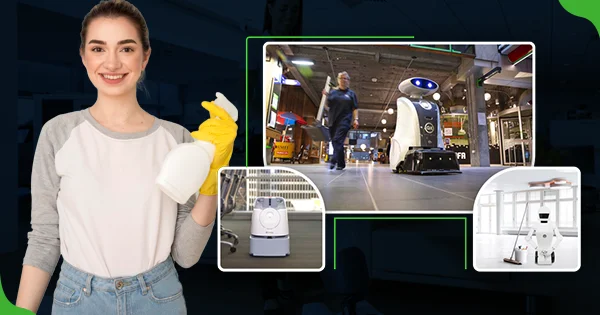A clean office environment is crucial for the productivity, well-being, and overall success of a company. A clean office creates a positive and conducive work environment, improving employee focus, motivation, and productivity. It also has a significant impact on employee well-being, reducing stress levels and improving mental health. In addition, a clean office reduces the spread of illness, improving employee health and reducing absenteeism. The psychological impact of a clean and organised workspace cannot be underestimated, as it reduces anxiety and promotes creativity. Maintaining a clean office environment is essential for promoting a positive company culture and enhancing professionalism and client perception. It also benefits employee morale and job satisfaction. In the long run, maintaining a clean office leads to cost savings, reduced maintenance and repair costs, increased employee retention, and reduced recruitment costs.
Importance Of a Clean Office for Employee Productivity and Well-Being
A clean office creates a positive and conducive work environment that can significantly impact employee productivity and well-being. When employees work in a clean and organised space, they are more likely to feel motivated and focused on their tasks. A clutter-free environment reduces distractions and allows employees to concentrate on their work more effectively. This improved focus leads to increased productivity and better quality of work.
In addition to productivity, a clean office also has a positive impact on employee well-being. A cluttered or dirty workspace can create stress and anxiety for employees. On the other hand, a clean office promotes a sense of calm and orderliness, reducing stress levels. This can have a significant impact on employee mental health, leading to improved overall well-being.
How A Clean Office Can Reduce the Spread of Illness and Improve Employee Health?
Maintaining cleanliness in the office is crucial for preventing the spread of germs and reducing the risk of illness among employees. Regular cleaning and disinfection practices can significantly contribute to improved employee health. By keeping surfaces clean and free from bacteria and viruses, the chances of employees getting sick are reduced.
A clean office also helps to reduce absenteeism. When employees are healthy, they are more likely to come to work regularly and be productive. On the other hand, a dirty or unsanitary office can lead to the spread of illnesses, resulting in higher rates of absenteeism. By prioritising cleanliness, companies can create a healthier work environment and reduce the impact of illnesses on employee attendance and productivity.
The Psychological Impact of a Clean and Organised Workspace
A clean and organised workspace has several psychological benefits for employees. Firstly, it reduces anxiety and stress levels. Clutter and mess can create a sense of overwhelm and make it difficult for employees to focus on their tasks. A clean and organised workspace promotes a sense of calm and orderliness, allowing employees to feel more relaxed and focused.
Furthermore, a clutter-free environment can also enhance creativity. When employees are surrounded by clutter, it can be challenging for them to think clearly and come up with innovative ideas. A clean workspace provides a blank canvas for creativity to flourish, allowing employees to think more freely and generate new ideas.
Lastly, organisation plays a crucial role in improving efficiency. When everything is in its place and easily accessible, employees can work more efficiently without wasting time searching for documents or supplies. This increased efficiency leads to higher productivity and better time management.
Tips For Maintaining a Clean Office Environment
Maintaining a clean office environment requires effort from both management and employees. Here are some practical tips for keeping the office clean:
✔️ Establish Regular Cleaning Schedules
Create a cleaning schedule that outlines specific tasks that need to be done daily, weekly, or monthly. This ensures that cleaning tasks are not overlooked or forgotten.
✔️ Designated Cleaning Areas
Set up designated areas for cleaning supplies and equipment. This makes it easier for employees to access what they need when cleaning their workspaces.
✔️ Proper Waste Management
Provide sufficient trash bins throughout the office to ensure that they are emptied regularly. Encourage employees to dispose of waste properly and recycle whenever possible.
✔️ Involve Employees
Encourage employees to take responsibility for maintaining cleanliness in their workspaces. Provide training on proper cleaning techniques and encourage them to keep their desks organised and clutter-free.
✔️ Hire Professional Cleaning Services
Consider hiring professional cleaning services for deep cleaning and maintenance. Professionals have the expertise and equipment to ensure a thorough and efficient cleaning process.
The Role of Cleanliness in Promoting a Positive Company Culture
A clean office environment plays a significant role in promoting a positive company culture. When employees work in a clean and organised space, it reflects professionalism and attention to detail. It creates an atmosphere of pride and respect for the workplace, which can have a positive impact on employee morale.
Setting cleanliness standards and promoting a culture of cleanliness among employees is essential. By establishing clear expectations for cleanliness and providing the necessary resources and support, companies can create an environment where cleanliness is valued and prioritised.
How Can a Clean Office Enhance Professionalism and Client Perception?
A clean office has a direct impact on client perception and trust. When clients visit an office that is clean and well-maintained, it enhances the company’s professionalism and credibility. A clean office sends a message that the company pays attention to details and takes pride in its work.
On the other hand, a dirty or cluttered office can create a negative impression on clients. It may give the impression that the company is disorganised or lacks attention to detail, which can undermine trust and confidence in the company’s abilities.
It is important to maintain a clean and presentable office for client meetings and visits. This includes keeping common areas tidy, ensuring that meeting rooms are clean and well-maintained, and providing comfortable seating arrangements for clients.
The Benefits of a Clutter-Free Workspace for Mental Clarity and Focus
Clutters can hurt mental clarity and focus. When employees are surrounded by clutter, it can be difficult for them to concentrate on their tasks and make clear decisions. A clutter-free workspace provides a clean and clear environment that allows employees to think more clearly and stay focused on their work.
In addition to mental clarity, a clutter-free workspace also improves productivity. When everything is organised and easily accessible, employees can work more efficiently without wasting time searching for documents or supplies. This leads to better time management and increased productivity.
To maintain a clutter-free workspace, employees should regularly declutter their desks and remove any unnecessary items. They should also establish systems for organising documents and supplies, such as using folders or storage containers.
The Connection Between Cleanliness and Employee Morale
A clean office has a direct impact on employee morale and job satisfaction. When employees work in a clean and well-maintained environment, they are more likely to feel valued and appreciated. A clean office creates a positive and uplifting work environment that can boost employee morale.
On the other hand, a dirty or unsanitary office can hurt employee morale. It can create feelings of frustration, discomfort, and even resentment towards the company. Employees may feel that their well-being is not a priority, leading to decreased job satisfaction.
Recognising and appreciating employees’ efforts in maintaining cleanliness is important. This can be done through regular communication, acknowledging their contributions, and providing incentives or rewards for maintaining cleanliness standards.
Strategies For Promoting Cleanliness and Tidiness Among Employees
Promoting cleanliness and tidiness among employees requires a proactive approach from management. Here are some strategies for promoting cleanliness in the office:
✔️ Regular Reminders
Send regular reminders to employees about the importance of cleanliness and tidiness. This can be done through email newsletters, bulletin board notices, or team meetings.
✔️ Training
Provide training on proper cleaning techniques and best practices for maintaining cleanliness in the office. This can include demonstrations on how to clean different surfaces, proper use of cleaning products, and waste management.
✔️ Incentives
Create incentives and rewards for employees who consistently maintain cleanliness in their workspaces. This can be in the form of recognition, small gifts, or additional benefits.
✔️ Lead by Example
Managers and supervisors should lead by example and maintain cleanliness in their workspaces. This sets a positive example for employees and reinforces the importance of cleanliness.
✔️ Involve Employees
Involve employees in decision-making regarding office cleanliness. This can be done through regular feedback sessions or suggestion boxes where employees can provide input on how to improve cleanliness in the office.
Long-Term Cost Savings for Maintaining a Clean Office
Maintaining a clean office is not only beneficial for employee productivity and well-being but also leads to long-term cost savings for the company. A clean office reduces the need for frequent maintenance and repairs. Regular cleaning and maintenance prevent dirt and dust from accumulating, which can cause damage to equipment and surfaces over time.
In addition, a clean office contributes to increased employee retention. When employees work in a clean and well-maintained environment, they are more likely to feel valued and satisfied with their jobs. This leads to higher employee retention rates, reducing the need for frequent recruitment and training.
Investing in cleanliness is a long-term investment for the success of the company. By prioritising cleanliness and maintaining a clean office environment, companies can save costs in the long run and create a positive work environment that attracts and retains talented employees.
Conclusion
A clean office environment is crucial for employee productivity, well-being, and the overall success of a company. A clean office creates a positive work environment that improves employee focus, motivation, and productivity. It also has a significant impact on employee well-being, reducing stress levels and improving mental health. In addition, a clean office reduces the spread of illness, improving employee health and reducing absenteeism. The psychological impact of a clean and organised workspace cannot be underestimated, as it reduces anxiety and promotes creativity. Maintaining a clean office environment is essential for promoting a positive company culture and enhancing professionalism and client perception. It also benefits employee morale and job satisfaction. In the long run, maintaining a clean office leads to cost savings, reduced maintenance and repair costs, increased employee retention, and reduced recruitment costs.
To prioritise cleanliness in the office, companies should establish regular cleaning schedules, designate cleaning areas, and ensure proper waste management. Involving employees in maintaining cleanliness and tidiness is also important. Hiring professional cleaning services for deep cleaning and maintenance can ensure a thorough and efficient cleaning process.
A clean office environment contributes to a positive company culture by reflecting professionalism and attention to detail. It enhances client perception and trust, as well as employee morale and job satisfaction. A clutter-free workspace promotes mental clarity and focus, leading to increased productivity. Strategies for promoting cleanliness among employees include regular reminders, training, incentives, leading by example, and involving employees in decision-making.










